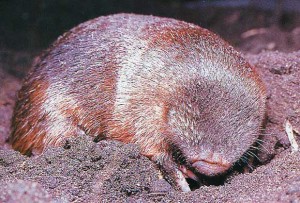I’m afraid that this week’s taxon of the week isn’t quite as topical as last week’s, but it’s something that I heard about in a talk recently and thought would be interesting to write about. The taxon in question is Necrolestes, a mysterious fossil mammal from South America.
The fossil material of Necrolestes consists of various fragmentary specimens from Patagonia dating to the early Miocene, about 16 million years ago. From these remains, Necrolestes has been reconstructed as a small, digging, insectivorous animal, perhaps similar to modern golden moles in ecology. While it’s obviously some kind of mammal it’s been assigned to various mammalian groups.
Before digging too deep into where Necrolestes fits into the picture of mammalian evolution, it’s worth having a look at the picture itself (in fact, see the picture below). Living mammals are divided into three groups: the placental mammals (most mammals you can think of, including you), the marsupials (kangaroos etc.) and the monotremes (echidnas and platypuses). Of these the marsupials and placentals are more closely related to one another than either is to monotremes, and together marsupials and placentals are known as therians. Monotremes, meanwhile, are found in a larger clade: australosphenidans. Various extinct groups of mammals also existed, which don’t fit into these groups. One such example is meridiolestids, a group of mammals that mainly died out in and shortly after the end-Cretaceous extinction event.
Over the years various phylogenetic analyses have been carried to work out where Necrolestes fits in this picture. Some of these have suggested it’s a member of the theria: a marsupial or a placental mammal. Others have put it on the stem of therians, and some specifically in the group mentioned before, the meridiolestids. Various recent studies have suggested this grouping, and while the placement of Necrolestes within the meridiolestids is variable in these studies, it does seem fairly likely that this is where it fits.
There are a number of interesting implications if, as seems likely, Necrolestes is a meridiolestid. One is that meridiolestids were around in South America for 46 million years longer than anyone thought. This is interesting in itself, as it leaves them with a massive ‘ghost range’ through the Cenozoic. Another, if you recall the small, fossorial ecology of Necrolestes, is that these meridiolestids were inhabiting pretty specialised niches. Parallels could in fact be drawn with modern monotremes, which occupy very specialised niches in Australasia, and are the remnants of a larger, more widely distributed group.
Necrolestes is thus an interesting example of how a small, fragmented fossil can have big and interesting implications. It looks like this small, South American creature was a (now dead) ‘living fossil’, a remnant of an otherwise ancient mammalian group, and while not currently particularly newsworthy, an interesting taxon to look at this week.



